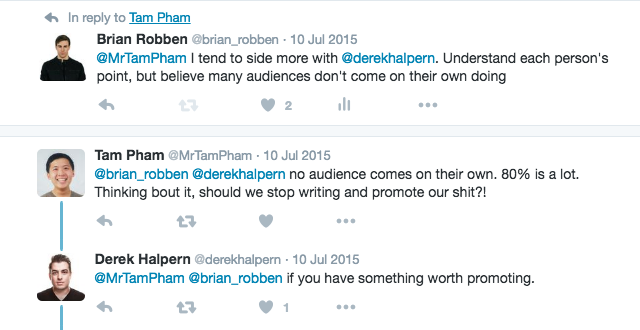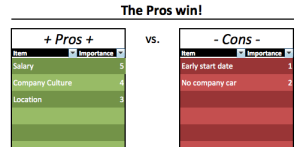Everyone is looking for a job on their university job board, going to career fair, and searching LinkedIn for job postings.
When traffic is hot at places like these, so is competition.
That means the likelihood of you standing out from the pack to get a job interview is low. And then being the best of these candidates to win the job is even lower.
I’m not knocking you; it’s just a reality.
Sure you can improve your chances of standing out to a recruiter with a knockout resume and practicing good interview answers. But why not combine a standout resume and specific interview stories with a more fruitful job board?
There’s one job board that you won’t think of but I’m extremely high on. On this job board you can find out exactly when a new job is posted, have conversations with the recruiters, and potentially hook yourself up for a job offer before needing to interview.
What’s the job board I’m talking about? Twitter. Twitter is super underrated but it can make a remarkable difference on your job search.
Why Twitter Is Great For Your Job Hunt
The masses go to LinkedIn for their job search and play around on Twitter for only social purposes.
However, thousands of recruiters, hiring managers, and employers are looking for candidates on Twitter. And Twitter offers some exclusive benefits that LinkedIn and other job boards don’t offer.
So these are the reasons to use Twitter as your job board.
Interact with recruiters: Twitter is a perfect tool to communicate with recruiters or companies. You’re not being too forward because you’re only doing what the platform is designed for by tweeting them. And tweets are much more public and personable than a private Facebook or LinkedIn message.
Search for companies: Instead of checking a year old job posting on a company’s website, search for them on Twitter to get immediate news. And remember that many companies have separate profiles for their human resources or recruiting teams that give you easy access to new job openings and recruiting windows.
Have companies search for you: With the right Twitter bio, a company can search for applicants and find your profile as a match. Now they’re chasing you instead of the other way around. This public visibility could be enough to get an interview that you didn’t know was open.
Increase credibility: Employers are sometimes spooked if an applicant they’re researching can’t be found on a major platform like Twitter. They also see it as a red flag when you haven’t been active on this site in months. An active Twitter presence eliminates these concerns.
Know about job openings first: It may surprise you that a lot of companies first reference a job opening on their Twitter profile. And sometimes, if you’re lucky, the job posting will only be advertised on Twitter. So all those who are not checking this company’s tweets will have no idea about it, but you’ll be on top of it.
Improve your personal brand: Landing a job is all about marketing yourself in the best light possible. It’s selling yourself and your skills, whether you like it or not. By having an account that’s littered with thoughtful tweets, consistent retweets of industry articles, and thousands of followers, it can only help you market yourself for your next job. I dive deeper into the importance of your digital resume in my book The Golden Resume.
So while your friends are tweeting back and forth about who is better between Steph Curry and LeBron James, you’ll know why to cultivate this amazing job board at your fingertips.
Now that you know why this platform works so well, here’s how to use Twitter to land a job.
How To Maximize Twitter
Here’s how to maximize Twitter so it becomes the x-factor in your job hunt.
1. Make your name your Twitter username (handle)
You want your Twitter username to be your first name and last name, e.g. @JohnSmith. If that’s taken, then add your middle initial between your first and last name, an underscore “_” between your names, or add the first initial of your first name with your last name, e.g. @JSmith.
Doing this will increase your visibility to recruiters and make it easier to execute the following steps.
And forget about the unprofessional play on your last name handles like @BenderOver or @CoxAndFox. Depending on how bad it is, people with handles like these are better off without a Twitter profile because it does more harm than good.
If your Twitter name isn’t already your name, then simply change it by going into your account settings and typing in your new username.
2. Create a positive picture and bio
Before you make external moves, you need to focus on your own profile so it appears sharp, professional, and interesting.
The first internal target is your picture. And a picture is worth a thousand words, whether it’s an art piece or your Twitter picture. So, although Twitter isn’t LinkedIn, you still want a high-resolution picture of your face where you look good. Toss the picture with your friends face cropped in half or the pic with terrible lighting.
Smiling pictures in good lighting usually do the best. Just make sure your face is identifiable to recruiters.
The next internal move is your Twitter bio. With a well-thought out description, companies can find you through search. To achieve this, write a few sentences that describe you, what job you’re looking for, and possibly a personal interest.
Here’s an example bio:
Recent grad at Rutgers University. Seeking entry level marketing position, and I’m willing to relocate. Go Red Sox!
Now you have the keywords “recent grad,” “entry level,” and “marketing position” that companies can find you for when searching. Plus you add a personal touch with the Red Sox reference.
To finish it off, add your blog to the URL space (this another reason to start a blog so you can show off your work to employers). If you don’t have a blog, add a link to your LinkedIn profile and call it a day.
3. Follow influencers in the specific industry where you want to work
What specific industry do you want to work? Engineering, accounting, finance, or journalism (etc.)?
Whatever it is, follow the 50 top companies in that industry. Or if you know you want to work on the west coast, follow the 50 biggest companies by your location. This won’t take you more than a few minutes.
Then dive deeper by doing research on the company websites to find out the names of recruiters or hiring managers from these companies. Search their names on Twitter and give them a follow.
Later on you’ll see how valuable it is to follow your interviewer and learn about their interests, personality, and values.
The more work you do in this step, the more opportunity there is to prosper in step 4.
4. Engage companies, recruiters, and social media managers with tweets
You didn’t do that work to your Twitter profile and follow a bunch of accounts to sit on the sidelines watching the action. Now is the time where you go to work to start conversations and contribute to discussions with these influencers.
This is the most important step!
Congratulate a company on winning an award. Retweet tweets from a recruiter or company that you find interesting. And reply to recruiters’ tweets with intelligent comments to keep the conversation going. Be active!
Consistent Twitter activity with these influencers over time will get you noticed and they will often personally respond to you. It’s not extremely difficult to get noticed because most brands don’t get routine engagement from a single account (which will be you, in this case).
And here’s the kicker. Now that you have their ear and they know your name, you can leverage these one-on-one Twitter discussions to private messages about upcoming internships or job opportunities. Sometimes these conversations result in job offers that weren’t even listed on the company site!
That’s why I love Twitter for the job search. It gets you access to opportunities that no one else gets, if you use it right.
In my example below, I wasn’t looking for a job. But I did interact with super successful entrepreneur Derek Halpern by simply tweeting at him with my friend Tam. It took ten seconds to send that tweet and get his attention.
5. Twitter search with hashtags
The benefit of searching for a job by a hashtag is sometimes the company announces it on Twitter before they publicly announce it on other mediums. Also, you can see who tweeted the information and possibly have a conversation with them to get rolling in the right correction (step 4).
There are two different Twitter searches to execute.
The first one is a Twitter search for career and industry specific hashtags such as:
#MarketingJobs
#AccountingJobs
#StartUpJobs
#FashionJobs
#SportsJobs
The second option, if you’re looking for a job at a specific company, is to type in the search bar the company name plus one of the following words: jobs, careers, hiring, now hiring, job listing, job posting, HR.
For example, if you know you want to work at Nike then search for “Nike jobs” and see what you find.
With a few tweaks to your Twitter profile and your activity, you’ll soon make yourself the front-runner for new jobs.
Other Helpful Twitter Habits
Secondary factors to improve your Twitter profile and impression on recruiters include:
- Tweet regularly. Don’t go months without a tweet or the employer will see you as inconsistent and flakey. Plus they won’t know if they can reach out to you through this platform anymore based on your inactivity.
- Research interviewers. If you get a job interview and are told Mrs. Susan Thornton is interviewing you, research her on Twitter to see what you can find out. Maybe you share something in common that can help you down the road. Also, familiarizing yourself with her will make you less nervous when you see her in person.
- Add photos or videos to your tweets. When appropriate, pictures and videos are proven to get more engagement and responses. This little touch to your tweets can give your profile a solid boost.
- Implement statistics. When you’re engaging others or tweeting, a statistic can support your claim and give you more credibility than anything else. Show you know your stuff instead of telling people you know your stuff. This also boosts the chances of you getting more likes and retweets because other people will feel smart retweeting you.
- Avoid grenade topics. Grenade topics involve political, social, and economic issues that are heavily debated. If you love Clinton or Trump, recruiters don’t need to know that about you. It can only hurt and rarely help. The reason I call them grenade topics is they can blow up in your face.
- Create a list. To separate the noise from your friends and potential employers, put the recruiters and companies you follow in a Twitter list. It’s easy to add a profile to a list by going to their profile, clicking on the settings icon, scroll down to add to list. And if you’re on the prowl for jobs in different industries, make separate lists.
Final Words
You can’t think too far outside of the box when you’re on the job hunt. That’s why if you give Twitter a shot, don’t be surprised if one tweet today, tomorrow, or next week has a link that leads you to your next job—or dream job.
So follow the action steps listed above to get the most out of Twitter. Here’s a reminder of what they are:
1) Make your name your Twitter username (handle)
2) Create a professional picture and bio
3) Follow influencers in the specific industry where you want to work
4) Engage companies, recruiters, and social media managers with tweets
5) Twitter search with hashtags
Instead of Twitter being a weakness for you in the job search based on questionable tweets and inactivity, you can flip the script to make it a champion for your job hunt.
And be sure to follow me @brianjrobben to get my newest articles, positive reinforcement, and updates in my life. I’m pretty active on this social media platform.
See you soon on Twitter!
Have you considered Twitter for your job search? Are you going to now? Why or why not?




